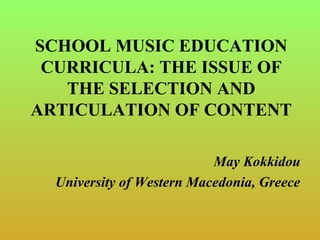Kokkidou school music education curricula
- 1. SCHOOL MUSIC EDUCATION CURRICULA: THE ISSUE OF THE SELECTION AND ARTICULATION OF CONTENT May Kokkidou University of Western Macedonia, Greece
- 2. Curriculum designers have thought that it was necessary ... • to begin with the examination of music as an acoustic phenomenon • to give emphasis to the factors of personal expression and creativity • to get out the socio-cultural context • to find ways to ensure plenty of actual musical activity
- 3. School Music aims at the acquisition of knowledge and the development of skills • about music • for music • through music
- 4. The content of a curriculum refer to… • Academic knowledge • Skills • Attitudes • Learning activities
- 5. Criteria for the selection of content • are influenced by the general orientations of the curriculum • should not be set out in advance • should be shaped in accordance with particular educational conditions
- 6. Aesthetic Education “Traditional” ways of structuring content have been: • By theme • Chronologically • Shared Concepts
- 7. The Content of School Music Curricula Inadequate and ineffective because • It cannot offer learners the chance to promote their own skills • it lacks that flexibility that would enable the teacher to adapt the material to the particular needs of each class
- 8. In order to maximize the knowledge we have to minimize the content
- 9. Current tendencies in the formation of curriculum content • Conscious listening is the crucial sector of the curricula • Most curricula stress the importance of activities that link music with the kinetic • Few curriculum focus emphatically on the acquisition of theoretical knowledge • Traditional music, whether as singing or as playing an instrument, does not find a place among the priorities of the curricula • There is a moderate to high emphasis on the cross- curricular element • The adoption of new technologies in the music lesson is limited
- 10. -What should be included in the content and for what reasons might something be excluded? -Does there need to be a hierarchical arrangement of content? -Are we more interested in the process or in the outcome? - If outcomes matter, then why should we not “teach to the test” that we intend to set? -If the process is more important, then why should we set a test at all?
- 11. Content forms a framework for teachers within which they may work discriminatingly, bearing creativity in mind, attempting to gain the assent of their learners.
- 12. Organizing the curriculum content • A progression from simple to complex • Rules for combination and logical relation • Pedagogically-oriented way of organizing material • Cross-curricular links • An organized structured built on the needs of learners with differing interests • Rejection of the strict following of a rigid institutionalized structure
- 13. Open-content movement The position of the Standards • A series of selected and “weighted” variables • A framework of basic concepts, knowledge and skills for the learners
- 14. 1. Singing, alone and with others, a varied repertoire of music 2. Performing on instruments, alone and with others, a varied repertoire of music 3. Improvising melodies, variations, and accompaniments 4. Composing and arranging music within specific guidelines 5. Reading and notating music 6. Listening to, analysing, and describing music 7. Evaluating music and music performances 8. Understanding relationships between music, the other arts, and disciplines outside the arts 9. Understanding music in relation to history and culture
- 15. Singing • Control of breathing • Articulation • Expressiveness • Singing from memory • Singing notated musical phrases • Technical accuracy (rhythm, pitch, tempo, intensity) • Singing alone • Singing with others, responding to the cues of a conductor (tutti, two-part & four-part harmonization) • Singing á cappella • Vocal imitation
- 16. Improvising • Instrumental and vocal improvisations Rhythmic question and answer phrases Melodic question and answer phrases Rhythmic / melodic accompaniments Rhythmic / melodic variations on a well-known melody Independent improvised rhythmic / melodic compositions • Improvisations with body percussion • Improvising using a variety of sound sources
- 17. …Coda The music lesson must not be confined to the transmission of information; rather, it must promote the construction of knowledge, the understanding of concepts and the development of skills.

















